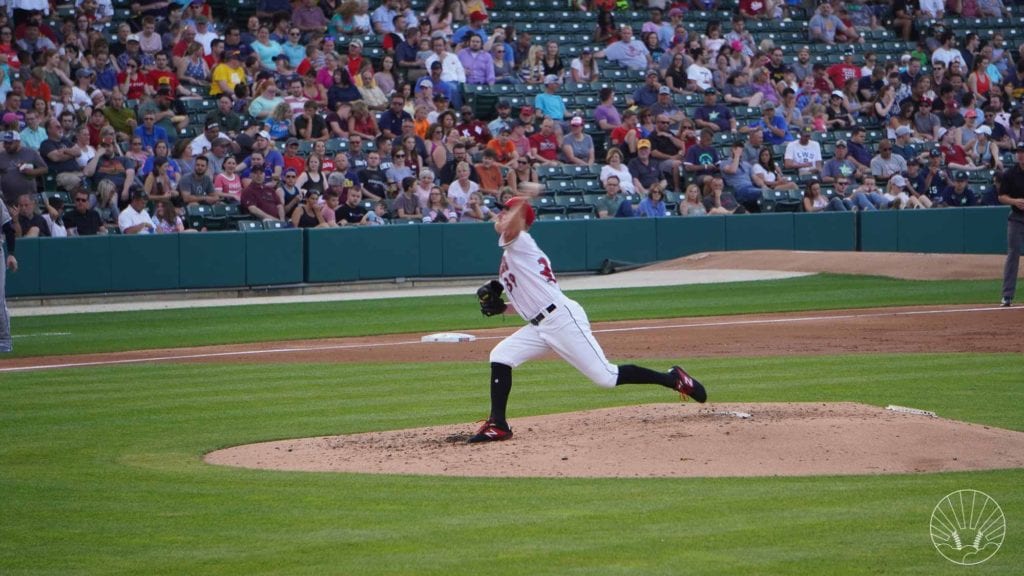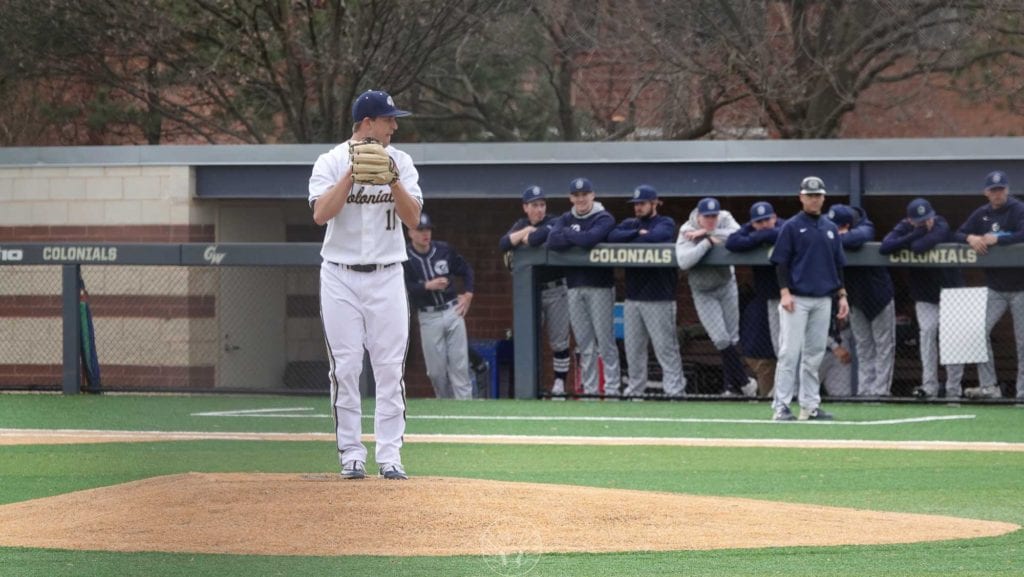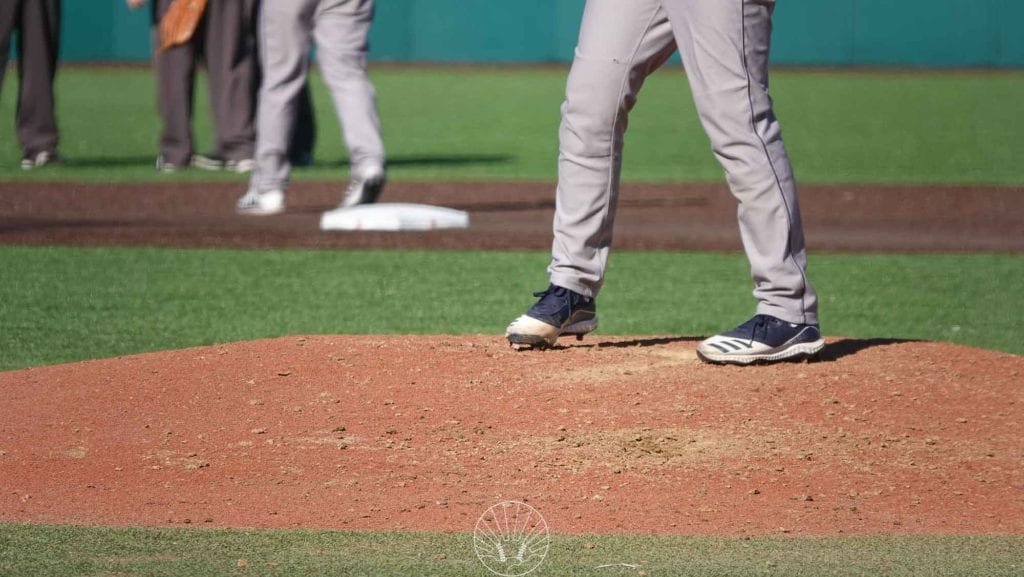*This article may contain product links which pay me a small commission if you make a purchase. Learn more.
What is a balk in baseball? According to the rulebook it’s an illegal act by the pitcher with a runner or runners on base, entitling all runners to advance one base. But it’s more complex than this, and there are 13 ways to balk in baseball, with only a few of those being most common – stopping and starting, not stopping when coming set, and flinching – which we’ll explain today in detail.
What does the rule book say about the 13 common ways a pitcher can balk? How can young pitchers learn these rules and prevent embarrassing mistakes at key moments in a game?

As a former pro pitcher, I’m here to walk you through baseball balk rules and help you understand the most important ones, so that in a key situation you–or your players–won’t make a silly mistake. There are a LOT more ways to balk than you’d think, and some are less well known than others.
Watch this Demonstration Video of All the Balk Rules
If you’d rather watch a great, detailed demonstration video of balk rules, jump in below.
And, this updated video with common questions about balk rules from the comment section of my Youtube channel.
Or, keep reading as we get to the bottom of what a balk is, and how coaches can help their players avoid them.
Table of Contents – Jump Ahead to Any Section in this Article
Official Definition of a Balk:
The official baseball rule book defines a balk as:
“an illegal act by the pitcher with a runner or runners on base, entitling all runners to advance one base.”
The official baseball rule book
In practicality, the main things to know about the mysterious balk in baseball are the following:
- All runners move up one base, including to home if a runner is on third
- If there are no runners on base, a balk is called an “illegal pitch” and a ball is added to the count
- If the pitcher still delivers the pitch, the batter can–and should–swing
- This is because he has nothing to lose – if the batter doesn’t get a base hit, then the balk call stands. If he does get a base hit and all runners advance one base, then that batted ball result stands.
- The catcher can cause a balk by not being in the catchers box (if there IS a catchers box drawn in chalk, which there often is not in amateur baseball)
As with anything in sports, seeing and doing is the best way to learn. So, I encourage you to check out this video below of MLB pitchers balking – you’ll see pitchers starting and stopping, twitching, dropping the ball, separating their hands twice, and other common balks. If you’re not sure what is a balk in baseball, then this will help.
Okay, now that you’ve seen a few examples of balks, let’s get to the rules.
Rule #1: You can’t start your pitching motion and stop, or have extra body movement
No matter the reason, a pitcher cannot stop his motion once he begins. This can mean a full-blown pitch is about to be thrown then the pitcher stops his delivery for some reason.

Or, and this is much more common, the pitcher subtly starts his motion but wasn’t quite ready, and then stops again. This could be a flinch or other subtle movement, and these are often caused by things the pitcher didn’t expect, like a runner stealing early and/or a fielder yelling at him to do something.
Pitchers do slip, trip and fall, but flinches are the most common version of stopping and starting.
Most of the time a balk is just a little flinch or movement.
Again, body movements and flinches count as starting and stopping. Once the pitcher comes set, he can only move his head, and his movements after accepting the sign–as he gets into his set position–also have to be smooth and without any erratic movements.
When a pitcher is on the rubber and has come set, he can only move his body if it’s part of doing one of three things:
- delivering the pitch
- stepping off the rubber
- picking off to a base
Any other body movements when set that are NOT part of one of these three will incur a balk call.
Flinching
Flinching is common when the pitcher is about to do something, but isn’t completely ready, such as after getting a sign or preparing to throw to first base, or when he sees a runner steal.
Pitchers have to be mentally tough to keep their body relaxed and quiet, so they don’t balk when unexpected things happen.
Body Movements
After accepting the pitch (while looking in for a sign), starting to move to come set, then stopping to get a different sign
This one is common – when a pitcher feels he’s got the information he needs – like the sign, etc. – then realizes he doesn’t or he missed something, he’ll often flinch, start to come set then stop and go back to looking in for the sign, etc.
Rule #2: You can’t fake a throw to first base
This applies to pick off moves for righties and lefties where they perform their first-base pick off move without stepping off the rubber. You cannot fake to first base when you do this otherwise legal pick off move.
Let me explain the difference.
Righty Pick offs to First
The main move to first base for righties can be legally performed with the back foot disconnecting forward from the rubber, as long as it is the first foot to move (the lead foot can’t move first on a move to first).
Yet, when this move is performed, the pitcher is NOT technically stepping off the rubber. Thus, when he picks off to first, he has to throw it, or else it’s a balk.
However, if a right-handed pitcher steps back off the rubber and then does a pick off throw to first, he is not bound by any pick off rules, because it’s not technically a pick off move any more. Once a pitcher steps back off the rubber, he’s the same as any fielder and can fake or throw to whatever base he wants.
Lefty Pick offs to First
The same is true here for lefties – if a lefthanded pitcher steps back off the rubber and then fakes a throw to first, it’s perfectly legal. The pick off move where this happens is called the snap throw. This is a legal step-off-then-throw pick off move that works well because lefties are facing first base.
The other left-handed pick off move, however, cannot be faked–this is the traditional, big hang move. Check out the video below or this article for more lefthanded pick off moves.
It can be pretty confusing whether or not a pitcher can fake to first base or not, so remember the following rule:
If you step back off the rubber, first, a fake is legal.
If you perform a pick off move where the first move is NOT a step back, off the rubber, then a fake is NOT legal – it is a balk.
Remember: It IS legal to fake a throw to second base
There are two pick off moves to second, one of which is the inside move, shown below in this instructional video.
Rule #3: While on the rubber, you can’t throw to a base without stepping toward it
This rule mostly applies to left-handed pitchers doing their hang move to first base. They have to step far enough toward first (umpires use an imaginary line drawn at a 45 degree angle toward first base as their rule) where the umpire deems that he stepped toward first rather than stepping toward home.
This rule also applies to righties doing a pick off move to third base, or the old (now illegal in most of baseball) fake-to-third-throw-to-first pick off move. When faking to third, many pitchers would lazily step pretty much right toward home plate, fake a throw to third real quick just to satisfy that part of the move, then quickly turn and throw to first.
Umpires enforced the rule that pitchers–if they were going to fake to third–needed to actually step toward third, rather than just putting their foot right back down toward home after lifting their leg.
But as a unofficial rule, there’s no good reason to pick off or fake to third base, so don’t even bother with it.
Rule #4: You can’t throw or fake a throw to an unoccupied base
This one is relatively straightforward except for the idea of what constitutes an unoccupied base.
What you can’t do: throw to a base where there was no runner.
What you CAN do: throw to a base where a runner is running.
Example of a Balk:
There is a runner on third base only. The pitcher cannot throw to–or fake to–second base.
Example – Not a Balk
There is a runner on second base. The runner begins stealing early and the pitcher steps off and throws to third. This is legal because the runner is going toward third.
Rule #5: You must come set and fully pause in the stretch position
This rule is subject to a little interpretation – the pitcher, when he comes set, must pause for at least one second before delivering the pitch. The pitcher is not allowed to simply “roll through” coming set.

When the hands come together, signifying that the pitcher has come to his “set position,” he must stop completely. Many pitchers, when they get in a rhythm and are pitching well, won’t really stop when their hands come together and will just go right into the delivery.
For more on coming set and the stretch position in general, watch the detailed video below.
Rule #6: You cannot perform a quick-pitch
This term is a bit vague and can mean different things depending on the context. There are legal and illegal types of quick pitches.
The Legal Type of “Quick Pitch” in Baseball
In this context, it means throwing the pitch before the batter is ready in the box, and it CAN be legal to quick-pitch a hitter in this sense. Here’s an example of Johnny Cueto doing this below, but let me explain what he actually did.
Cueto usually has a high, relatively slow leg kick. His typical delivery is slow and hitters get used to this slow pace.
In the video below, he starts his delivery just the same but shortens his leg kick dramatically and is on his way to the plate in about half the time of normal, and thus ruins the hitter’s timing. This type of quick pitch is legal – the batter is ready to hit, time is “in”, and Cueto has simply chosen to have a quick delivery on this one particular pitch, unbeknownst to the hitter.
Few pitchers choose to use this tactic because pitching is a very rhythmic activity, and so most prefer to stay in their normal rhythm, timing and tempo so they can control their body as best they can.
The Illegal Type of Quick Pitch
Yet, there are illegal quick pitches that are ruled a balk in our beloved game of baseball. Here’s how it would go:
The pitcher is completely set and ready to pitch early, and as soon as the hitter puts one foot into the box, he delivers the pitch.
Assuming time was “in”, which it certainly could be, the umpire could call this a balk.
The umpire usually regulates this by keeping time “out” until the batter is reasonably ready to hit, and points to the pitcher yelling “play” when time is back in.
But sometimes the umpire does not call time out between pitches, and so it could set the stage for a quick pitch, at which point the pitcher could deliver the ball before the hitter even has a clue its on its way.
Why a quick pitch can be dangerous
This is dangerous because hitters are often looking down at their feet or hand when the first step into the box, as they’re trying to get their body in the right spot and get set up. If the pitcher delivers a pitch at that moment when the hitter isn’t looking at him…he could look up and find the pitch right between his eyes.
Marcus Stroman, who also uses quick-pitches to his advantage, was called for an illegal pitch in 2017, though it appeared that it was perhaps not the correct call.
Rule #7: You can’t pitch while not facing the batter
To be quite honest, I’ve never seen this balk called in a game in my entire career as a coach or player. In googling it, doing my diligence for this article, I couldn’t find any examples either.

So, my guess is as good as yours here, and feel free to leave a comment if you have any links to share that show this balk.
My assumption is that looking at the runner on 2nd base while starting the pitching delivery is what they’re talking about, but the official baseball rules don’t elaborate, as far as I read.
I’ve seen many pitchers over the years staring at the runner on 2nd base (and I’ve done this myself), and then lift their leg to start their delivery. Technically, the deliver starts with the pitcher NOT looking at the batter. But what does “facing” actually mean?
What does “Facing the Batter” Mean?
Typically when we use the term facing, we mean the whole body turned toward someone.
“Turn and face me when you’re talking!” – My mom had said this many times throughout my adolescent years, when I was being an annoying teenager.
But would it be right to say that facing my mom was just turning my head toward her while my body was angled away? No – that’s not really how we use the term.
And yet here, the pitcher’s chest is never facing the batter – the pitcher is facing first base (lefties) or third base (righties) when in the stretch position.
So do they mean “looking”? I don’t know. Your guess is as good as mine, but I’m assuming the rule should read, “pitcher must be looking at the batter when he starts his delivery.”
Again, comment below if you know the exact details here.
Rule #8: You can’t perform part of the pitching motion while not on the rubber
Pitching happens on the rubber. This rule is common sense because the pitcher is not allowed to deceive the batter or runners. So pitchers, you can’t act like you’re going to pitch when you’re not on the rubber – this would scare runners into getting their secondary leads or running to the next base, which would make them easy outs.
Don’t act out your pitching motion – just pitch the ball when you’re ready to do so.
Rule #9: You can’t unnecessarily delay the game
This one is self-explanatory. I’ve never seen a delay of game balk called in all my years of baseball, but it’s in the rule book to prevent it if some pitcher does decide to throw a hissy fit and pace around the field all day.
Rule #10: You can’t stand on–or straddle–the rubber without the ball
Again, just like in rule #8, a pitcher can’t trick runners into thinking he’s about to pitch–or is actually pitching–when he isn’t.
So, it’s a rule that when a pitcher straddles (stands with one foot on each side of) or stands on the rubber, he has to have the baseball in his hand or glove.
Rule #11: You can’t separate the hands once in the set position
This rule goes back to set position – once the pitcher comes set, his hands have come together for the first and last time before delivering a pitch. Once the hands come together inthe glove, the pitcher’s only way to break them is by stepping back off the rubber first. Once the pitcher steps off the rubber, he is free to do whatever he wants.

But again, once the hands come together in the set position, they must stay that way until the pitch is delivered or a pick off is performed.
Rule #12: You can’t drop the ball while on the rubber
Sorry pitchers – you may not mean to, but if you drop the ball, it’s a balk.
Rule #13: The catcher must be in the catcher’s box for a pitch
The catcher has to be behind the plate in his little area
More Related Pitching Videos & Articles
If you’re here learning about balk rules, you’re probably either a parent or coach of a young ballplayer. If that’s the case, the following videos and articles will be a big help to you.
- This detailed article is all about pitching mechanics – it’s very thorough
- This article is all about the slide step and set position mechanics
- Subscribe to my YouTube Channel – it’s filled with baseball videos on tons of topics
- Try out my Online Baseball Strength Training Program called Early Work.
And, grab copies of my two baseball books below (note: both are links to Amazon, where I make a commission on sales through the amazon affiliate program)
Pitching Isn’t Complicated is my pitching manual for all ages
Dear Baseball Gods is the story of my career, an inspirational read for baseball fans of all ages.
Listen to My Baseball Podcast with Tons of Tips for Pitchers
Dear Baseball Gods is downloaded nearly 1000 times each week – listen in for quick tips for players, coaches and parents!
FAQ – Weird Baseball Balk Rules & Questions Answered
Have more questions about the balk rule in baseball? Try these common questions below. And, be sure to look up your local rulebook – every locale is different.
What happens if a balk is called and the batter hits the pitch?
If a balk is called and the pitcher still delivers the pitch (which is very common), the hitter can swing away (and should!) with no penalty. What happens is that if the batter hits the balk pitch, and the batted ball results in all runners advancing at least one base (including the batter – so it must be a base hit), then the balk is disregarded and the batted ball result stands. It should be noted that a runner could be thrown out still on this hit–such as trying to go two bases and thrown out at third or home–and the play would still stand, so the pitcher would get an out on the balk hit in this instance. If the batter hits the ball and gets out or runners do not advance at least one base, then the balk would stand–the runners would move up one base, a ball would be added to the count and the hitter would resume his at-bat.
What is a balk in baseball?
The official baseball rule book defines a balk as “an illegal act by the pitcher with a runner or runners on base, entitling all runners to advance one base. If a pitcher balks with no runners on baseball, a ball is called since no runners are available to advance.
How many ways can you balk in baseball?
There are 13 ways to balk in baseball, and most of them are relatively simple and don’t require much thought as a pitcher once you learn them. Knowing the body parts you can and cannot move while on the rubber is a key part of avoiding balks, and for most young pitchers simply learning a pre-pitch routine will help avoid most of them.
Is a balk an error?
No. A balk is not an error, and the result is a ball added to the count (if no runners on base) and each baserunner gets to advance one base if there are. The hitter’s at-bat then resumes, but no error is added to anyone’s statistics.
Can a catcher balk?
Yes. A catcher must be in the catcher’s box before the pitcher leaves a pitcher’s hand, otherwise the umpire will call a balk. This is not often an issue in amateur baseball, as many fields will not even have a catcher’s box lined, so this call would be impossible to make. The rule book states: “Except that when the batter is being given an intentional base on balls, the catcher must stand with both feet within the lines of the catcher’s box until the ball leaves the pitcher’s hand.”
What is a quick-pitch in baseball?
A quick pitch is when the pitcher delivers a pitch before the hitter has time to get ready in the batter’s box. Though the umpire typically does not call “play!” meaning, “time in!” until the batter is somewhat ready, it’s possible that time could be in and the pitcher is ready. Thus, the pitcher could try to deliver right away and sneak one past the hitter. This is dangerous, as an errant pitch thrown to a hitter who doesnt realize a pitch is coming, could be disastrous.

